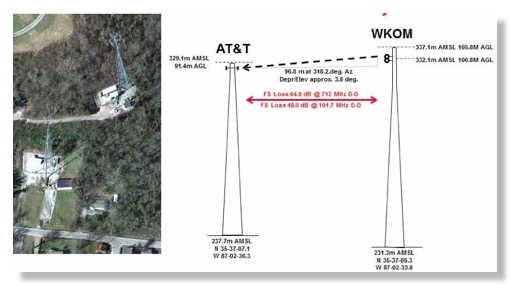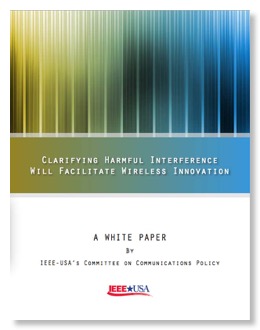FM Broadcast -> 700 MHz LTE Interference Problem Reveals Basic FCC Spectrum Policy Problems

On June 25, 2013 our friends at CommLawBlog published a surprising post that has not received much attention. It was entitled “Harmonic Convergence? FM Interference to 700 MHz LTE Service” and was authored by Peter Tannenwald.
The post starts:
The introduction of different species into an established ecosystem tends to be a dicey proposition. Almost invariably, co-habitation requires the sharing of scarce resources. And more often than not, the different species approach the whole sharing thing in different, not entirely compatible, ways. The result: occasional dissatisfactions and frustrations – leading to occasional inter-species frictions and fisticuffs.
Take the RF spectrum ecosystem, for example.
Most inhabitants of the spectrum have historically figured out ways to coexist in relative peace (at least for the most part) – thanks largely to the fact that the potential impact of one service on another has been taken into account in the frequency allocation process. But as the demand for spectrum increases, and every little niche is filled up, it is becoming more difficult to avoid inter-service conflicts. And sure enough, the introduction of a recent new species – 700 MHz wireless systems using LTE equipment – seems to be causing some unexpected problems.
The post goes on to describe an emerging problem of interference from FM broadcast stations to 700 MHz cellular base stations nearby. A search of the FCC website on this issue found no public documents on the FCC’s voluminous website dealing with this issue. Fortunately Google found several non-FCC documents published after Mr. Tannenwald’s breaking post.
Barry Mishkind at The Broadcasters' Desktop Resource (BDR) published a report on June 28, 2013 that is linked to a detailed technical discussion of the issue. The public trail of this event appears to begin on 6/19/13 with the issuance of a Notice of Violation* by the FCC’s Enforcement Bureau’s New York District Office to WKZE-FM in Salisbury CT. The NOV alleges that their signal on 98.1 MHz had an 8th harmonic at 784.8 MHz that was causing interference to a VZW base station located approximately 500 feet away. The NOV cited 73.317(a):
(a) FM broadcast stations employing transmitters authorized after January 1, 1960, must maintain the bandwidth occupied by their emissions in accordance with the specification detailed below. FM broadcast stations employing transmitters installed or type accepted before January 1, 1960, must achieve the highest degree of compliance with these specifications practicable with their existing equipment. In either case, should harmful interference to other authorized stations occur, the licensee shall correct the problem promptly or cease operation. (Emphasis added.)
A major issue here is whether the above clear rule take precedent over the Commission’s general “first in time, first in right philosophy”** that is stated neither in the law nor as a general codified rule. We will leave it to our legal friends to parse case law on this issue.
Clearly the NAB crowd and the CTIA crowd have a major difference in viewpoint here. NAB’s past quixotic attempts to require all cell phones to have FM receivers certainly is not helping these industry giants’ mutual relationship, especially at this time of incentive auction focus by all.
We have not seen any public statements from the cellular community on this issue, so Scott Baxter’s comprehensive 10/13 presentation to the Association of Federal Communications Consulting Engineers, a mainly broadcast engineering group, is the most definitive discussion of the technical issue on the public record. (Scott’s usual clients appear to be mostly wireless firms.)
It is unclear what the technical problem here really is, although there seems no controversy that the FM transmitter in question meets the numeric out of band emission limits of § 73.317(d):
(d) Any emission appearing on a frequency removed from the carrier by more than 600 kHz must be attenuated at least 43 + 10 Log10 (Power, in watts) dB below the level of the unmodulated carrier, or 80 dB, whichever is the lesser attenuation.
Several possible hypotheses:
- This out of band emission level of § 73.317(d) is not adequate to protect 700 MHz LTE base stations x meters away.
- The usual measurement procedure for determining this emission limit may focus too much on the power that goes to the antenna and not enough on incidental leakage from the transmitter cabinets that might have inadequate shielding in some models. (This is consistent with observations in the Baxter briefing.)
- The emission limit is adequate, but loose metal connections in or near the cellular antenna structure generate harmonics from the strong FM signal a few hundred feet away just as intermodulation products are generated in strong electromagnetic fields when there is a dense concentration of transmitters such as Mt. Wilson, CA and Sandia Ridge, NM.
- The cellular base station receivers may be inadequately filtered/shielded and subject to desensitization in strong fields from the FM transmitter hundreds of MHz away. Despite years of talk, FCC still has no general policy on receiver performance issues.
- The IEEE-USA harmful interference white paper, released in July 2012, urges FCC to clarify the issue of “minimum protection distance” with respect to all interference issues since generally any receiver will get interference if it gets too close to a transmitter. While there are clear precedents for a few cases such as personal computers near TV receivers and UWB devices near PCS cell phones, FCC has no general position on this issue or even a process to determine minimum protection distance. Thus the cellular interests will say there is should be no interference at 500 feet and the broadcaster will disagree.
- Rather than keeping this issue off the public agenda, as it has so far except for the difficult to find NOV, FCC should be engaging industry experts in an open and transparent way. This highlights one of the problems of the FCC’s Technological Advisory Committee (TAC): it is not set up to handle this type of problem as it consists mostly of technical policy managers of key players, not the technical experts in the area (National Academy of Engineering members and IEEE Fellows are rare) and meets infrequently. Thus there is no indication of any TAC involvement to date as this problem threatens LTE roll outs. Note that another IEEE-USA 2012 product, “Position Statement on Improving U.S. Spectrum Policy Deliberations in the Period 2013-2017” addressed the issue of improving advisory function based on best practices of other regulatory agencies with technical jurisdiction:
FCC and NTIA should supplement their existing Technological Advisory Council (TAC) and Commerce Spectrum Management Advisory Committee (CSMAC), which consist mainly of representatives of major communications firms, with a new advisory committee that serves both agencies and focuses on independent review of options for resolving spectrum conflicts and identifying outdated policies. The new group should be modeled on the EPA Science Advisory Board and the NRC Advisory Committee on Reactor Safeguards and members should have the necessary security clearances to deal with issues involving classified federal government spectrum users, if so requested.
- “Emerging interference” has been a recurring topic in this blog. In our dynamic wireless industry it is not surprising the new and unexpected interference mechanism appear in practice and need timely attention, for the bigger they become they usually become harder to solve. But for decades FCC has had no mechanism for dealing with emerging interference issues. Thus the police radar detector interference to VSAT receivers took more than a decade to resolve (the official FCC records “fuzzify” the starting date of the problem) and the “cellular booster” issue took 6+ years. FCC needs a generic and transparent problem for identifying such issues promptly and for engaging the public on which need urgent attention and which deserve “benign neglect”. For example, home TV antennas with built-in amplifiers, rare prior to DTV, are a recurring source of interference to TV and other services at a modest rate and it is marginal whether the issue needs regulatory attention at this time. But how many top FCC managers and 8th Floor residents are aware of this and other emerging issues?
- This is closely related to the reason why the Commission’s Spectrum Policy Task Force originally raised the issue of “interference temperature” a decade ago. The goal was to define better what environment systems should expect in practical operation. It may well be that the designers of these base station never considered an environment with a strong FM signal present from a nearby transmitters. But the NOI/NPRM in Docket No. 03-237 was so poorly and confusingly written that FCC closed the docket in 2007 and has never expressed any further interest in the issue. Whether or not interference temperature is ever used as a basis for allowing more unlicensed use, quantifying expectation really would help incumbents and would allow timely resolution of controversies such as this FM/LTE one.
Your blogger has filed a FOIA request with FCC seeking all correspondence on this issue with outside parties relating to the NOV. It does not seek internal FCC documents that have various FOIA exemptions. These documents will be posted here as soon as they are available. However, unless they embarrass Rupert Murdoch, that probably won’t be soon.
* The NOV URL given is from the FCC website, BUT we have found no way to get there unless you happen to have bookmarked the URL for Notices of Violation and Notices of Unlicensed Operation issued by Field Offices or the Enforcement Bureau’s old home page - no longer linked to the main FCC website.
** - The “newcomer” policy dates back to Midnight Sun Broadcasting Co., Memorandum Opinion and Order, 11 FCC 1119 (1947), in which the Commission held a broadcaster responsible for resolving interference caused by its new facilities to other preexisting facilities in close proximity. See FCC 13-115 at para. 4 and fn. 7
UPDATE
In a tweet responding to this post, Brett Glass hypothesized “FM could be hitting inadequately shielded IF stages in LTE equipment.”




![Validate my RSS feed [Valid RSS]](valid-rss-rogers.png)

